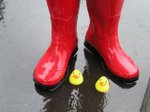 There are many marvelous things about Katherine Ashenburg's new book The Dirt on Clean: An Unsanitized History, not least of all the brilliant design. Outside the book resembles a bar of soap, while the text inside is laid out beautifully, scattered with small graphics and quotations. The book is artful in style and content, the graphics ranging from Greek and Roman images of bathing to 2oth Century soap advertisements. That Ashenburg uses these images and literary evidence as her sources, as well as more traditional historical record, suggests a rich resource. Ashenburg's prose is compelling and enjoyable to read, the subject matter fascinating and full of illumination, and here we have a book on a most unlikely subject which a wide range of readers is bound to appreciate.
There are many marvelous things about Katherine Ashenburg's new book The Dirt on Clean: An Unsanitized History, not least of all the brilliant design. Outside the book resembles a bar of soap, while the text inside is laid out beautifully, scattered with small graphics and quotations. The book is artful in style and content, the graphics ranging from Greek and Roman images of bathing to 2oth Century soap advertisements. That Ashenburg uses these images and literary evidence as her sources, as well as more traditional historical record, suggests a rich resource. Ashenburg's prose is compelling and enjoyable to read, the subject matter fascinating and full of illumination, and here we have a book on a most unlikely subject which a wide range of readers is bound to appreciate.Where I do find fault, though, I do unfairly. For it is unfair to fault a book for being exactly what it purports to be. Simply a history of cleanliness, focusing on the Western world, and arguing that a people's view of cleanliness tells you much about who those people are. And there is so much stuff with which to work on this subject, as Ashenburg makes clear, but I couldn't help wishing that she'd worked it a little more. Even the ubiquitous quotations and factoids suggest to me that so overwhelmed was she by the richness of her facts, she could neither harness them completely nor let any of them go. So we get a compendium of miscellanies instead of a book, the kind of trivia so fashionable these days, the kind which gets pulled out at parties whenever knowledge is called for. That changing one's shirt was once all that was required by way of hygiene, how disgusting Europeans seemed to the rest of the world, and how clean must have been Odysseus considering that the Greeks bathed upon their departures and arrivals.
Have you heard about"Knol"-- the the new Google version of Wikipedia? I think they made up "knol", but the term is supposed to stand for the smaller bits that knowledge can be broken down into. The idea bothers me, for I don't think that knowledge can really be broken down. Knowledge is the sum of its parts, synthesis being required for an assemblage of facts to mean anything, and such synthesis was what was missing as I read The Dirt on Clean.
But I am being doubly unfair, I realize. For I cannot claim to be so knowledgeable as much as merely "knolly" myself, and if Katherine Ashenburg had written a book called, for example, "An Academic Treatise on European Bathing Practices and Society in the 16th Century" and said book had not been designed to look like a bar of soap, I probably would never have even read it. Ashenburg's book is undeniably charming, and though its facts left me with questions, I can seek the answers elsewhere. That the book raised questions at all makes it more useful than a "knol" and could well set me on a path toward knowledge after all. Being a popularization of history does not taint that history, and though I maintain that Ashenburg could have pressed her analysis further, that she has written such a good book with such wide appeal is probably healthy for everybody.

